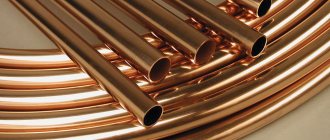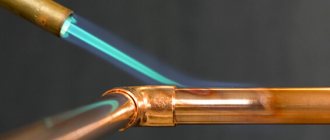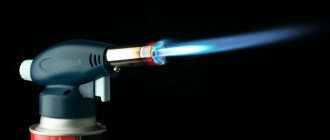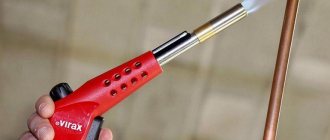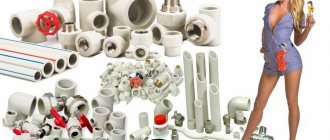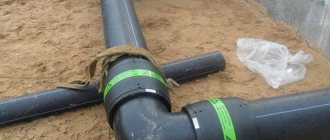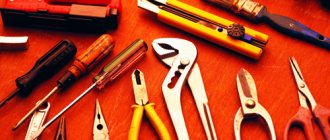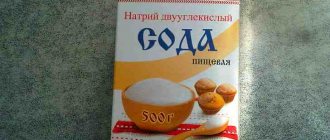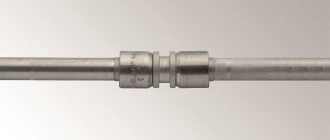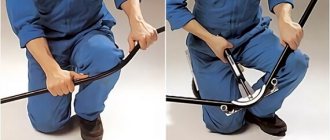When joining copper products, various tools and equipment are used, without which the soldering process would not be possible.
The main tool is a soldering iron. In addition, you can use a gas burner or special ovens. At home, it is preferable to use soldering of copper products; this option is the simplest and fastest compared to cooking. In addition, you do not need special equipment to carry out the fastening. If all the rules and conditions of the technological process are observed, a strong and reliable connection of elements can be obtained, increasing resistance to various loads.
To ensure that soldering at home does not cause difficulties, first of all you need to take care of the basic tools that will be involved in this process:
- pipe cutter;
- chamfer;
- pipe expander;
- steel brush;
- steel brush;
- solder;
- burner or hair dryer.
For a tubular device, a method is used when the element is immersed in a composition of salt and solder. Salt acts as a heat source and replaces the functions of flux. Therefore, additional flux is not needed.
In addition to this method, there are several other soldering options that deserve attention.
Soldering copper
Preparation for soldering copper with aluminum, brass, stainless steel, iron
The preparatory period, which includes the acquisition of the necessary devices, materials, personal protective equipment, and the soldering procedure itself.
There are two ways to solder copper to copper: high and low temperature. The first involves heating the metal to 900°C, and is used for pipelines with high pressure or temperature load. For high-temperature soldering, materials intended for this are used: hard solder in the form of rods (the melting point of such solder is about 900°C) and hard-melting flux.
In order to solder copper using the low-temperature method, it is sufficient to heat the metal to 600°C (usually 300–380°C), which is achievable in domestic conditions. For the procedure, soft solder is used for soldering copper and brass in the form of a wire or rod with a cross-section of up to 3 mm and a more fusible flux. Solder is an alloy of tin, which is more than 97%, with other metals: copper, selenium, silver, antimony.
Why do you need flux? Correctly soldering copper pipes can only be done with flux - a special paste-like composition (with zinc chloride), which is applied to the surface of the connected sections of the pipe in a wide strip. It performs several functions:
- prevents the process of metal oxidation by removing oxygen;
- improves the adhesion of solder to copper;
- is an indicator of sufficient heating of the metal, signals when to apply solder and solder the copper;
- promotes uniform spreading of solder along the joint.
Safety precautions. Despite the simplicity of the process, soldering copper pipes must comply with safety rules. The danger of burns is posed not only by the burner flame itself, but also by the heated metal. Copper conducts heat well, so during operation, not only the area on which solder is placed and welding is carried out, but also the entire pipe becomes very hot, and it cools down slowly. If you need to solder copper tubing that is not already built into the piping system, preparation involves placing it on non-flammable supports where it can take a long time to cool. Before touching the welded metal from its place, you should wait until it cools completely.
The immediate danger is the open flame of the burner, so you need to purchase a tool that is convenient to work with: preferably with a movable nozzle on a long hose
Safety precautions when soldering copper
It should be taken into account that the heat conductivity of copper is very high, as a result of which it is not recommended to solder parts while holding them in your hands without protection; this will most likely result in burns. Parts shorter than 30 cm are handled exclusively with pliers or in protective gloves. If during the soldering process flux drips onto exposed parts of the body, you need to immediately wash it off with soap and water, since, in addition to thermal burns, you can get a chemical burn.
For any work with open fire and hot metal, as well as flux that contains acid, synthetic clothing is undesirable, since such fabric ignites and melts much faster than others. Be sure to ventilate when working; smoke from burnt flux is harmful.
If you have absolutely no soldering skills, it is advisable to practice on scraps of pipes or wires before performing important work. There are few difficulties in this work, and 2-3 times, as a rule, are enough to master all the basic techniques. If the plumbing system is being assembled, it is recommended to pre-assemble it on the floor before installing everything in place. After assembly and soldering, the system should be thoroughly rinsed with hot, clean water to remove any flux and solder from the inside of the pipes.
Plumbing or heating systems made from copper pipes are expensive, but they are strong and durable. Since copper has a high thermal conductivity coefficient, good anti-corrosion and antibacterial properties, pipelines made from it are efficient and durable. Soldering copper at home is not difficult: a socket-coupling is put on the pipes, and then the seam is sealed. Instead of using a flare, sometimes they widen the end of one pipe and insert another into it. This connection is convenient because it does not require fittings, and the service life is equal to the life of the pipes themselves.
Necessary materials and equipment: tin and others
The following tools are required for working with copper pipes:
- pipe cutter, hacksaw or grinder with a thin disk;
- chamfer;
- pipe expander (expander);
- soldering flux;
- solder;
- soldering iron for copper, for example, a propane torch for soldering copper pipes;
- rubberized gloves;
- paper napkins.
Pipe cutters of various sizes are used to cut pipes. Larger samples have a large turning radius and are inconvenient to use in hard-to-reach places, so if there is a need to cut off a section of a finished installed water supply, use a small pipe cutter. You can cut the pipe with a hacksaw or a grinder with a thin disk, but a better cut can only be achieved using a pipe cutter.
After the pipe is cut, the burrs are removed. This is necessary to ensure that there is no turbulence in the fluid flow in the system. When there are no obstacles, the water supply does not experience stress and works like a clock.
Before welding the copper, the ends of the pipe are polished with fine-grained sandpaper, which can be purchased at hardware stores. They clean both surfaces that are preparing for soldering. Sometimes small brushes with a diameter of Ø 22 mm are used for these purposes; they are suitable for almost all pipes. For cleaning, the stem of the brush is inserted into a screwdriver or drill, with the help of which the process is carried out faster and with better quality.
Flux is applied to the cleaned, smoothed outer surface - a composition that prevents the oxidation process of copper.
Rubberized gloves are used to protect hands, since when cutting copper and burrs, many small metal elements are formed that dig into the skin like splinters. In addition, when cleaning the surface with a drill, the rotating brush chews on rag gloves.
To solder copper correctly, you need to take into account that from the moment of stripping and applying flux to soldering, no more than half an hour should pass, otherwise the stripping must be repeated again. If the flux is applied with a brush, there should be no bristles or hairs from it left on the surface - otherwise the connection will not be tight and the pipeline will leak after water is supplied.
After inserting the pipe into the socket, the remaining flux is not completely removed with a napkin, it remains on the connection in the form of an edge of 1–2 mm, and when soldering, the solder is drawn inward - the capillary effect is triggered. First, the joint is heated with a burner, and the moisture between the walls is evaporated. Then the burner is brought up a second time, the copper gradually heats up, and the flux takes on a tin appearance. At this moment, solder is placed on the front side, soldering occurs, and the molten alloy flows down to the back side, solidifying as it moves. The excess metal overhangs that form below are separated on their own. Soldering copper can be done in different ways.
Preparation for soldering copper with aluminum, brass, stainless steel, iron
The preparatory period, which includes the acquisition of the necessary devices, materials, personal protective equipment, and the soldering procedure itself.
There are two ways to solder copper to copper: high and low temperature. The first involves heating the metal to 900°C, and is used for pipelines with high pressure or temperature load. For high-temperature soldering, materials intended for this are used: hard solder in the form of rods (the melting point of such solder is about 900°C) and hard-melting flux.
In order to solder copper using the low-temperature method, it is sufficient to heat the metal to 600°C (usually 300–380°C), which is achievable in domestic conditions. For the procedure, soft solder is used for soldering copper and brass in the form of a wire or rod with a cross-section of up to 3 mm and a more fusible flux. Solder is an alloy of tin, which is more than 97%, with other metals: copper, selenium, silver, antimony.
Why do you need flux? Correctly soldering copper pipes can only be done with flux - a special paste-like composition (with zinc chloride), which is applied to the surface of the connected sections of the pipe in a wide strip. It performs several functions:
- prevents the process of metal oxidation by removing oxygen;
- improves the adhesion of solder to copper;
- is an indicator of sufficient heating of the metal, signals when to apply solder and solder the copper;
- promotes uniform spreading of solder along the joint.
Safety precautions. Despite the simplicity of the process, soldering copper pipes must comply with safety rules. The danger of burns is posed not only by the burner flame itself, but also by the heated metal. Copper conducts heat well, so during operation, not only the area on which solder is placed and welding is carried out, but also the entire pipe becomes very hot, and it cools down slowly. If you need to solder copper tubing that is not already built into the piping system, preparation involves placing it on non-flammable supports where it can take a long time to cool. Before touching the welded metal from its place, you should wait until it cools completely.
The immediate danger is the open flame of the burner, so you need to purchase a tool that is convenient to work with: preferably with a movable nozzle on a long hose
What is needed for soldering copper pipes
Soldering copper pipes, which is not difficult to do with your own hands, does not require expensive equipment or any special materials. In order to carry it out correctly, you will need the following equipment.
A burner that will heat the solder and the section of pipes where they will be connected. Such a burner is usually supplied with propane gas, the pressure of which is regulated using a welding reducer. Special device for cutting copper pipes. Since products made from this metal are very soft, they should be cut gently enough so as not to crush the walls. The modern market offers pipe cutters of various models, differing in both their functionality and technical capabilities.
The design of individual models of such devices, which is important, allows them to be used even for working in hard-to-reach places. A pipe expander is a device that allows you to expand the diameter of a copper pipe, which is necessary in order to perform soldering better. Various systems mounted from copper pipes use elements of the same cross-section, and in order to connect them efficiently, it is necessary to slightly increase the diameter of one of the elements being connected
This is precisely the problem that a device such as a pipe expander solves.
Copper pipe flaring kit
A device for chamfering the ends of copper pipes. After trimming, burrs remain on the ends of the parts, which can interfere with obtaining a high-quality and reliable connection. To remove them and give the ends of the pipes the required configuration, a bevel remover is used before soldering. There are two main types of chamfering devices on the market today: those placed in a round body and those made in the form of a pencil. More convenient to use, but also more expensive, are round devices that can process soft copper pipes with a diameter of no more than 36 mm. To properly prepare copper pipes for soldering, it is necessary to remove all contaminants and oxides from their surface. For these purposes, brushes and brushes are used, the bristles of which are made of steel wire. Typically, brazing of copper pipes is performed with hard solder, which can be high- or low-temperature. High-temperature solder is copper wire containing about 6% phosphorus. Such wire melts at a temperature of 700 degrees, while for its low-temperature type (tin wire) 350 degrees is sufficient. The technology for soldering copper pipes involves the use of special fluxes and pastes that perform a protective function. Such fluxes not only protect the seam being formed from the formation of air bubbles in it, but also significantly improve the adhesion of the solder to the pipe material.
In addition to flux, solder and other basic elements, to solder copper pipes you will also need additional tools, which can be found in every workshop or garage. To solder or cook copper products, additionally prepare:
- regular marker;
- roulette;
- building level;
- a small brush with stiff bristles;
- hammer.
Before starting work, it is also important to decide how to solder copper pipes. There can be two main options: soldering copper with hard solder (used less frequently) and using soft solder
When addressing this issue, it is important to assume that there are requirements for the use of one or another type of solder. Thus, hard solders are used for soldering elements of refrigeration units and air conditioners. In all other cases (water supply systems, heating systems, etc.) tin wire can be used. But no matter what technology is chosen, it should be remembered that flux is necessary in any case.
Cleaners for cleaning the inner surface of a copper pipe before soldering
Twists for distribution boxes with welding
If we need to connect two or more solid copper wires and hide them in the junction box, then for a reliable connection it is better to weld the contacts. To do this, we will additionally need a special welding machine with carbon electrodes. For example, the TSS Compact-160 welder is suitable for such a task. You will also need graphite electrodes (you can take rods from AA batteries or a graphite block from the engine) and flux.
First we twist the two wires, as in the picture, starting from the ends and ending with the base.
Then, using a welding machine, weld the ends (only them, no need to weld along the entire length).
After this, you need to insulate the twists with electrical tape/heat shrink and carefully place them in the junction box.
Of course, welding takes more time than, for example, WAGO clamps or other terminal blocks, but such twists last for decades, and your grandchildren will change them.
Copper soldering rules
If you need to solder a copper product or a product containing copper components, it is impossible to give a definite answer as to how and what is the best way to do this. The choice of method and tools depends on many factors, such as the size and weight of the parts, their composition. The load to which already soldered products must be subjected is also taken into account. There are several soldering methods, and it is better to know them all so that, if necessary, choose the most suitable one.
Soldering large parts
Scheme of capillary soldering of copper.
If you need to solder massive or large parts that cannot be heated to the required temperature with a soldering iron, a torch and copper solder are used. The flux in this case is borax. The strength of copper-phosphorus solder is higher than that of standard tin.
A thin layer of flux is applied to the mechanically stripped pipe or wire. After this, a fitting is put on the pipe, also mechanically cleaned. Using a gas torch, the joint is heated until the flux-coated copper changes color. The flux should become silver in color, after which you can add solder. The solder melts instantly and penetrates into the gap between the pipe and the fitting. When drops of solder begin to remain on the surface of the pipes, the solder is removed.
The pipes should not be overheated, as this will not promote a greater capillary effect. On the contrary, copper heated to blackness is less amenable to soldering. If the metal begins to turn black, heating should be stopped.
Soldering wires or wires
To solder thin copper wires, do not use zinc chloride solder as it will destroy the copper. If there is no flux available, you can dissolve an aspirin tablet in 10-20 ml of water.
Scheme of copper welding in an inert gas environment.
Copper wire or parts made of wire of various sections can be easily heated to the desired temperature using a soldering iron. The temperature regime should be the one at which the solder, tin or lead-tin, melts, and this is what soldering is done with. Fluxes must contain rosin or be made on its basis; solder oil or even rosin itself can be used.
The surface of the wire is cleaned of dirt and oxide film, after which the parts are tinned. This process involves applying a thin layer of flux or rosin to heated copper, and then solder, which is distributed over the surface as evenly as possible using a soldering iron. The parts requiring connection are connected and heated again with a soldering iron until the already solidified solder begins to melt again. When this happens, the soldering iron is removed and the connection cools.
The parts can be clamped in a vice so that the distance between them is 1-2 mm. Flux is applied to the parts and heated. Solder is brought to the gap between the hot parts, which will melt and fill the gap. The melting point of solder for soldering using this method must be lower than the melting point of copper so that the parts do not become deformed. The part cools, then it is washed with water and, if necessary, sanded with sandpaper until smooth and uniform.
Soldering utensils or soldering holes in copper
When soldering dishes, they use pure tin, the melting point of which is higher than that of tin or lead-containing solder. Sometimes, to solder large parts, hammer soldering irons are used, heated over an open fire with a gas burner or blowtorch. In the future, everything happens according to the standard scheme: stripping, flux and tinning, joining parts and heating with a soldering iron. It is for this soldering iron that pure tin solder is convenient.
On the inside, the fitting usually has a border that prevents it from being threaded through the pipe. It can be removed using a coarse file if the fitting needs to be pushed onto the pipe further than intended and thus soldering an unnecessary hole.
Correct procedure
Wires should be tinned using a soldering iron in accordance with an algorithm verified by many years of practice. At the very beginning of work, you need to carefully remove the outer insulating layer of the wires with a knife or pliers. It is advisable to remove at least 10 mm and maximum 50 mm from the polymer coating from each connected end.
After this, use the same knife to clean the surface to a shiny state. This will eliminate the presence of remnants of the insulating sheath and remove oxide deposits from the wires.
Thick wire is easier to hold and clean. If the cable includes several thin wires, it is advisable to fray them, separate them, strip them on all sides, and then twist them again.
Then you can heat up the soldering iron, first checking the cleanliness of the tip. The surface will only be well maintained if it is absolutely clean.
Using a heated soldering iron, you should heat the prepared, thoroughly stripped ends of the wires, dipping them in rosin. The rosin needs to coat the wire well.
Use the soldering iron tip to take the solder and evenly distribute the mixture along the cut of the wires, which are fixed with tweezers or ordinary pliers. To ensure complete application of the mass of molten consumables, the wires should be rotated around their own axis.
Copper wire can be treated not only with rosin, but also with acidic flux. Some people prefer to use something that is always commercially available. A special flux is provided for tinning aluminum wires.
Features of soldering with soft and hard solders
The connection of copper pipes has a number of characteristic features. They are especially pronounced when using different materials.
Soldering of links with low-melting solder is carried out at a temperature of 175–315ᵒC. Soldering with solid compounds is carried out by heating the joint to a temperature of 650–815ᵒC.
Soft alloy soldering is used for soldering copper pipes with an internal diameter of up to 22 mm, and hard alloy soldering with a diameter of 22 mm or more.
Soft and hard solders - description
When sufficiently heated, the applied flux layer boils. When soft solder melts, a molten drop is formed, which plays an important role in creating a strong pipe connection. Boiling flux pushes the molten composition out of the joint space. Under the action of capillary forces, the solder alloy is drawn into the joint as it cools.
When butt brazing, a thin spacer of soft metal is inserted between the elements being soldered. The parts to be connected are securely and firmly fixed with a guide gasket.
A simple technique for soldering copper pipes and the availability of all materials allows you to do this work yourself at home.
Related video: Soldering copper pipes “my experience”
Selection of questions
- Mikhail, Lipetsk — What discs should I use for cutting metal?
- Ivan, Moscow - What is the GOST for rolled sheet steel?
- Maxim, Tver - Which racks for storing rolled metal products are better?
- Vladimir, Novosibirsk — What does ultrasonic processing of metals without the use of abrasives mean?
- Valery, Moscow - How to forge a knife from a bearing with your own hands?
- Stanislav, Voronezh — What equipment is used for the production of galvanized steel air ducts?
How to solder?
Let's look at how to properly solder using various options.
Pipes
When creating a pipeline, you can solder its parts together even at home. Pre-cleaning is easy and does not require aggressive components. High-temperature soldering takes place at temperatures from 450 degrees. The solder in this situation is silver or copper itself. Capillary high-temperature soldering usually involves the use of BAg or BcuP compounds.
It is recommended to anneal the metal to pre-soften it. Natural cooling of prepared seams helps prevent excessive loss of strength properties. Increased airflow, especially immersion in cold water, is contraindicated. Hard soldering is used for pipes with a cross-section of 1.2-15.9 cm, high-temperature soldering is used for gas pipelines. In plumbing practice, strong heating is important if monolithic joining of parts with a diameter of more than 2.8 cm is carried out, or if it is necessary to ensure the circulation of a liquid heated to more than 120 degrees.
High-temperature processing is also used when forming heating circuits. It will be possible to easily create a branch from an already prepared system without dismantling work. Low-temperature processing makes it possible to obtain seams with a width of 0.7 to 5 cm. Due to its low strength, such a connection is unsuitable for joining gas pipes. But the absence of annealing allows you to maintain strength at a decent level, and the procedure itself is safer; in this way you can get seams from 0.6 to 10.8 cm.
Pipe cutting to size is usually done with a hand pipe cutter. An even cut is obtained by holding the workpiece strictly at an angle of 90 degrees to the fixture. The parts being connected should not contain any burrs or burrs that could interfere with the passage of liquid. Before applying flux, parts will have to be degreased. Excess flux is unacceptable; as soon as an even layer of it is applied, you can connect the parts of the pipeline and solder them to each other.
Source
Soldering process
It consists of performing sequential operations:
- the pipe is cut into pieces of the required sizes, which are marked for convenience - supply or return;
- a chamfer is removed from the edge;
- the edges are cleaned by 2 cm: the outer ones on the pipe, as well as the inner ones in the socket;
- Flux is applied in a strip along the cleaned surfaces (external and internal);
- the connection is assembled: the pipe is inserted into the socket;
- excess flux is removed with a paper napkin, but not completely - an edge of 1–2 mm is left;
- the burner is ignited, the flame is brought to the junction;
- the surface is heated for 10–15 seconds to a certain temperature - the flux should acquire a tin color;
- Solder is placed on top of the joint; when heated, it will be drawn into the joint and spread along the seam, filling it.
If the connection joint has not been cleared of bristles or dust, and as a result the soldered seam of the copper water pipe leaks, then the tightness can be restored using one of two methods:
Using a soldering iron
- the surface is cleaned, treated with phosphoric acid, heated with a soldering iron, and tin is applied;
- using a torch: flux is applied to the cleaned surface, heated, solder is applied, and melted.
How to properly solder copper with a gas torch
You can solder a copper tube as follows:
- Clean the soldering area with a fine file, sandpaper or wire brush.
- Grind rosin and sprinkle the soldering area.
- Heat the tube over a gas flame until the rosin melts.
- Place POS-30 or 40 solder and melt it with a soldering iron, spreading it over the surface.
In everyday life, copper processing is encountered not only when it is necessary to solder copper heating or water pipes, but also in car repair if a crack or leak appears on the car radiator. In this case, you do the soldering of the copper radiator yourself. Instead of a gas torch, car enthusiasts use a powerful 250 W electric soldering iron for copper pipes. To strip copper, use sandpaper or a metal brush, and for soldering tin, rosin or orthophosphoric acid is used as soldering acid.
Soldering with a soldering iron at home
Soldering copper with a soldering iron is easier than using a torch. The procedure looks like this:
- The surface of the radiator is cleaned with fine-grained sandpaper or a brush.
- A few drops of acid are evenly applied to the edges of the damaged area.
- The crack is heated with an electric soldering iron and solder is applied. Having melted, the tin fills the hole.
Independent soldering of copper heating or water supply pipes, repairing cracks in radiators is a simple technology process that can be done at home with a small set of tools.
WATCH THE VIDEO
Soldering copper at home is something every man can do.
Connecting wires
Before connecting the wires in the junction box, we advise you to study the rules for their installation.
After all, it is important not only to properly connect the wires to each other, but also to correctly insert them into the junction box, and also conveniently position them for possible inspection or repair
Rules for installing wires in a junction box
First of all, let's look at the rules for the arrangement and installation of wiring in the distribution network. After all, it is with this factor that any installation begins.
- First of all, you should remember that no more than eight groups of wires can be laid in one groove, box or pipe.
- All connections must be made in accordance with clauses 2.1.17 - 2.1.30 of the PUE. These clauses provide for a whole range of restrictions. First of all, remember that the wire in front of any contact must have a reserve sufficient for at least one reconnection.
- Before connecting the wires in the junction box, make sure that they are free of tension. Or that this tension will not occur due to temperature changes.
- Any wire connection points must be accessible for repair and inspection. At the same time, these places should be organized so that inspection is not hampered by structural elements.
- Any connection must be insulated. In this case, this insulation must correspond to the level of the main insulation. To achieve these parameters, it is better to use electrical tape or heat shrink.
- The distribution boxes themselves must be made of fireproof or fire-resistant materials. like in the video. This is especially true for the installation of wiring on combustible structures, which are subject to additional requirements.
Options for connecting wires in a junction box
First, let's look at how to connect the wires in a junction box. After all, it is the contact connections that are often the most vulnerable point of any electrical network and any shortcomings appear very quickly.
According to clause 2.1.21 of the PUE, all connections of wires and cables must be made by welding, soldering, crimping, screw or bolt compression. Other connection methods, especially twisting, are not allowed. Based on this, let's look at each of the possible connection methods separately.
The most reliable connection of wires is considered to be the welding method. It has the lowest transition resistance, resulting in virtually no increased heating. In addition, over time, such a compound does not lose its properties.
Welding of wires in the junction box is carried out using a special welding transformer and a carbon electrode. The cost of such products is high enough for a simple replacement of wiring in an apartment, so you can often find homemade devices. Typically these are transformers up to 600 W and voltage 9 - 36V.
The second place in reliability is the connection using the soldering method. This method is more accessible for home use because it does not require special equipment other than a regular soldering iron.
Connecting wires by soldering
Soldering of wires in the junction box is carried out using conventional technology and does not impose any special requirements.
The only point worth paying attention to is the quality of such connections. After all, if heated, the tin will heat up quickly enough and the contact will disappear. To prevent this, soldering is often combined with a twisted connection.
To prevent this, soldering is often combined with a twisted connection.
Wire crimping has recently become increasingly popular. After all, a large number of fairly cheap tools for crimping wires have appeared on the market, and the price of consumables for this method is quite low.
But the most common method is still the screw or spring clamp method. A huge number of buses and terminals currently on the market allow for a fairly reliable connection of wires.
Note! Screw terminals should be used to clamp single-core wires. If you use stranded copper wire, then you need to purchase special tips that will prevent the screws from breaking the strands of the stranded wire when clamping. These lugs are attached to the wire using the crimping method.
These lugs are attached to the wire using the crimping method.
